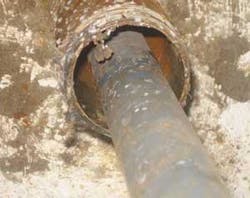No Longer Worried about Corrosion
• Conversion to CPVC piping system at Lubrizol's Avon Lake Wastewater Treatment Plant in Ohio eliminates corrosion and related productivity and maintenance problems
When your wastewater treatment plant is expected to be operational 24/7 and is under the additional pressure of treating a variety of harsh industrial chemicals in the water stream, you can't afford downtime as a result of corrosion and leaking pipes. That was the challenge faced by Lubrizol's Avon Lake, OH, wastewater treatment plant in 2005.
Lubrizol, a global manufacturer of specialty chemicals, makes an array of chemical products at its Avon Lake plant, including thermoplastic polyurethane, polyurethane dispersion (PUD), high performance latex products and additives primarily used in personal care products. To effectively treat a diverse mix of process waste streams before sending its water back to the local municipal plant, Lubrizol uses an alum-based polymer coagulant to break solids out of solution and into suspension. The coagulant, which weighs 25% more than the weight of water, is pumped through a 1-in. line and fed into the wastewater in a mix tank. The challenge, until 2005, had been the low pH level of the feed stream, which wreaked havoc on the pump room's stainless steel piping system.
According to Tim Dillon, Lubrizol's operations supervisor for wastewater treatment and facilities, the stainless steel line was in operation for nearly two years when it started to develop ongoing corrosion problems. By the third year, we were spending so much time either repairing the pipe or replacing full sections of the line that we felt we had no choice but to completely replace the material to avoid all of the downtime and safety risks associated with the overhead leaks, said Dillon. With the low pH level and type of treatment chemicals we were using, the obvious choice was to convert to CPVC pipe and fittings.
Dillon's team was already familiar with the benefits of CPVC because, nearly 10 years earlier, CPVC pipe and fittings were installed for the polymer coagulant bulk unloading line. Over a decade later, the CPVC system was still operating reliably without any downtime or maintenance issues.
After three years of 24/7 operation, the newer CPVC line installed in the pump room's polymer coagulant feed line is demonstrating the same reliable performance. We have had zero problems with the CPVC system, said Dillon.
In addition to the system's corrosion resistance, Dillon noted that another reason for using CPVC piping was its higher heat deflection temperature noted by the cell class of the pipe material – 24448 – as defined by ASTM D1784. This meant the pipe would appear rigid and not sag once in service. We knew there were other non-metallic options available, but we needed a pipe we were confident would remain rigid, despite the weight of the heavy liquid, said Dillon.
Not only has the CPVC system's performance been flawless, but its installation was fast and easy. Downtime as a result of the conversion from stainless steel to CPVC was minimized thanks to a solvent cement welding system that eliminates the need for hot work in a chemical plant. Since CPVC pipe weighs only about one-sixth the weight of steel, it was also safer and easier to install. To protect it from freezing outdoors, Dillon's team used electric heat tracing and insulated the CPVC line.
This system pumps thousands of gallons of polymer coagulant through its lines each month, said Dillon. We need to run continuously to keep up with production demands. Plus, we have the added challenge of needing to treat for a wide variety of highly aggressive chemicals. We can't afford corrosion. That's why CPVC will continue to be the material of choice for new lines or replacement lines here at Avon Lake. It's reliable, and when you factor in the cost of materials, downtime and maintenance for the stainless system, CPVC represents a much lower total installed cost.
Corzan Piping Systems – for corrosive and high temperature applications as well as water distribution systems – are a product line of Wickliffe, OH-based Lubrizol Corp. Contact: www.corzancpvc.com

